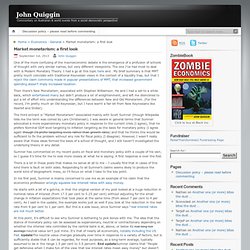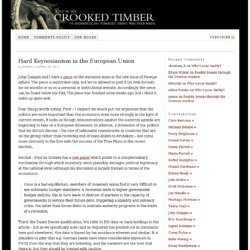

Sandpit. Market monetarism: a first look. One of the more confusing of the macroeconomic debate is the emergence of a profusion of schools of thought with very similar names, but very different viewpoints.

The one I’ve had most to deal with is Modern Monetary Theory. I had a go at this topic here and . My brief summary is that MMT pretty much coincides with traditional Keynesian views in the context of a liquidity trap, but that I reject the claim commonly made in popular presentations of MMT, that increased government spending doesn’t imply increased taxation. Then there’s New Monetarism, associated with Stephen Williamson. He and I had a set-to a while back, which entertained many but didn’t produce a lot of enlightenment, and left me disinclined to put a lot of effort into understanding the differences between New and Old Monetarism.
The third entrant is “Market Monetarism” associated mainly with Scott Sumner (though Wikipedia tells me the term was coined by Lars Christensen). Anyway, that’s enough from me. Money for nothing? Whenever I write anything about public expenditure and taxation, I’m likely to get someone commenting that Modern Monetary Theory has shown that a government with its own currency does not need taxation to finance public expenditure.

I’ve tried a couple of responses to this, but now I think I can explain better why this argument is (a) wrong in terms of (what I understand to be) the central claims of MMT (b) regressive in terms of taxation policy (c) politically pernicious Starting at the beginning, as I read the central argument of MMT on fiscal policy, it is based on the idea of functional finance. The idea is that governments should first decide on the appropriate level of public expenditure, that is on the allocation of resources between public and private consumption and investment. Next, they should consider the requirements of macroeconomic policy to determine appropriate levels of money creation and issue of public debt.
Some propositions for chartalists (wonkish) I’ve been asked quite a few times about chartalism and its recent rebadging as modern monetary theory (MMT).

My answer has been that I really should get around to looking into this. However, the issue came up again at Crooked Timber following my post on hard Keynesianism. Looking around, I drew the conclusion that an attempt to define and assess the various versions of MMT would take more time than I had available. So, instead, I thought I would draw up a set of propositions bearing on the claims I made about hard Keynesianism and invite comment from MMT advocates and others as to whether they disagree. Here they are 1. 2. 3. 4. 5. Hard Keynesianism in the European Union. John Quiggin and I have a piece on the eurozone mess in the new issue of Foreign Affairs.

The piece is subscriber-only, but we’re allowed to post it (in Web format) for six months or so on a personal or institutional website. Accordingly, the piece can be found below the fold. The piece was finished some weeks ago, but I think it holds up quite well. Four things worth noting. First – I suspect we would put our argument that the politics are more important than the economics even more strongly in the light of current events. Second – Paul de Grauwe has a new paper which points to a complementary mechanism through which monetary union plausibly damages political legitimacy at the national level (although his discussion is largely framed in terms of the economics). Third: the Daniel Davies qualification. Finally – the piece is written in the rhetorical style of US policy articles.
How to Save the Euro—and the EU Reading Keynes in Brussels By Henry Farrell and John Quiggin May/June 2011.